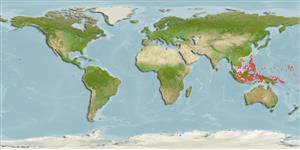Environment: milieu / climate zone / depth range / distribution range
Ecologia
marino associati a barriera corallina; distribuzione batimetrica 1 - 30 m (Ref. 90102). Tropical; 30°N - 9°S
Western Pacific: Moluccas, Philippines, Ryukyu Islands, Palau, Yap, and Guam.
Size / Peso / Age
Maturity: Lm ? range ? - ? cm
Max length : 6.0 cm TL maschio/sesso non determinato; (Ref. 48636)
Spine dorsali (totale) : 4; Raggi dorsali molli (totale) : 8; Spine anali: 0; Raggi anali molli: 7. Identified by moderately long tentacle behind the eye and numerous small leafy appendages on the body (Ref. 48636).
Inhabits sand of shallow reefs, from tide pools to as deep as 30 m (Ref. 1602). Also inhabits sheltered reef lagoon habitats, usually in on algae reef near seagrass beds (Ref. 48636). Occurs solitary in weedy areas and sand-rubble bottoms (Ref. 90102).
Life cycle and mating behavior
Maturities | Riproduzione | Spawnings | Egg(s) | Fecundities | Larve
Myers, R.F., 1991. Micronesian reef fishes. Second Ed. Coral Graphics, Barrigada, Guam. 298 p. (Ref. 1602)
IUCN Red List Status (Ref. 130435)
Threat to humans
Harmless
Human uses
Strumenti
Special reports
Download XML
Fonti Internet
Estimates based on models
Preferred temperature (Ref.
123201): 28 - 29.4, mean 28.9 °C (based on 931 cells).
Phylogenetic diversity index (Ref.
82804): PD
50 = 1.0000 [Uniqueness, from 0.5 = low to 2.0 = high].
Bayesian length-weight: a=0.00794 (0.00359 - 0.01758), b=2.80 (2.61 - 2.99), in cm total length, based on LWR estimates for this (Sub)family-body shape (Ref.
93245).
Trophic level (Ref.
69278): 2.9 ±0.25 se; based on food items.
Resilienza (Ref.
120179): Alto, tempo minimo di raddoppiamento della popolazione meno di 15 mesi (Preliminary K or Fecundity.).
Fishing Vulnerability (Ref.
59153): Low vulnerability (10 of 100).
